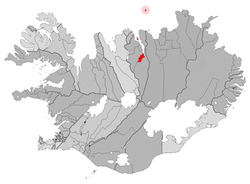Akureyri | |
|---|---|
 An aerial view of downtown Akureyri | |
 Location of the Akureyri Municipality | |
| Country | Iceland |
| Region | Northeastern Region |
| Constituency | Northeast Constituency |
| Government | |
| • Mayor | Ásthildur Sturludóttir |
| Area | |
| • Total | 138 km2 (53 sq mi) |
| Population (2021)[1] | |
| • Total | 19,219 |
| • Density | 131.82/km2 (341.4/sq mi) |
| Postal code(s) | 600, 601, 602, 603, 611, 630 |
| Municipal number | 6000 |
| Website | akureyri |
Akureyri (Icelandic pronunciation: [ˈaːkʏrˌeiːrɪ], locally [ˈaːkʰʏrˌeiːrɪ] ) is a town in northern Iceland, the country's fifth most populous municipality (under the official name of Akureyrarbær [-ˌeiːrarˌpaiːr̥], 'town of Akureyri') and the largest outside the Capital Region. The municipality includes the town's neighbourhood at the head of Eyjafjörður and two farther islands: Hrísey at the mouth of Eyjafjörður and Grímsey off the coast.
Nicknamed the "Capital of North Iceland", Akureyri is an important port and fishing centre. The area where Akureyri is located was settled in the 9th century, but did not receive a municipal charter until 1786.[2] Allied units were based in the town during World War II. Further growth occurred after the war as the Icelandic population increasingly moved to urban areas.
The area has a relatively mild climate because of geographical factors, and the town's ice-free harbour has played a significant role in its history.
- ^ "Population by municipalities, sex and age 1 January 1998–2019 – Current municipalities". PX-Web. Retrieved 7 April 2019.
- ^ Evans 2008, p. 310
